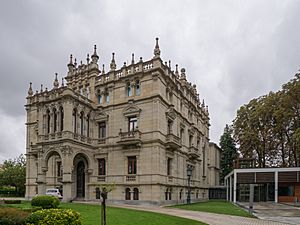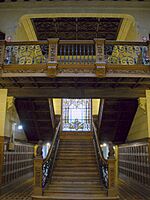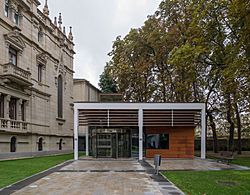Museo de Bellas Artes de Álava facts for kids

A view of the museum building
|
|
| Established | 1942 |
|---|---|
| Location | Fray Francisco Street, 8, Vitoria-Gasteiz |
The Museum of Fine Arts of Álava is a famous art museum in Vitoria-Gasteiz, a city in the Basque Country region of Spain. The museum is housed in a beautiful old building called the Augustin Zulueta Palace.
Inside, you can see Spanish art made between the 18th and 20th centuries. It has a special focus on Basque art created from the 1850s to the 1950s. The museum first opened its doors in 1942.
Contents
The Palace's Story
The building that is now the museum was once a private home. It was built for a wealthy couple, Elvira Zulueta and Ricardo Augustin.
A Grand Home
In 1912, Elvira and Ricardo decided to build a mansion in a fancy neighborhood of Vitoria. Elvira came from a rich local family. The couple hired two well-known architects, Julián de Apraiz and Francisco Javier de Luque, to design their new home. These architects were already famous for designing the city's new cathedral.
Building the palace was a big project, and it was finished in 1916. Sadly, Elvira passed away suddenly in 1917. After her death, Ricardo spent less and less time at the palace. By 1930, he had moved to Madrid for good.
Becoming a Museum
The palace was mostly empty for many years. In 1941, after the Spanish Civil War ended, Ricardo Augustin sold the palace to the provincial government of Álava.
The government wanted to create a place to store and show the province's art and history. They called it Casa de Álava (House of Álava). It would hold art, historical objects, a library, and the province's official records.
The new museum received art from many places. The local church, called the Diocese of Vitoria, donated religious art. The famous Museo del Prado in Madrid also sent some pieces. People also donated art from their private collections. The Museum of Fine Arts of Álava officially opened in 1942.
Growing the Collection
Over the years, the museum's collection grew and changed. In 1975, the museum started collecting modern art. This collection grew to become one of the best in Spain.
For a short time, from 1978 to 1980, the Basque art collection was moved to a nearby palace called Ajuria Enea. But when Ajuria Enea became the official home for the president of the Basque government (the Lehendakari), the art was moved back.
The museum also once had a large collection of playing cards. This collection was later moved to its own museum, the Fournier Museum of Playing Cards.
In 1999, the museum closed for major updates. The religious art was moved to a new museum for sacred art. The modern art was moved to a new contemporary art museum called Artium. Today, the museum has a new entrance and more space for visitors.
What to See Inside
The museum's art is spread across different floors, showing how art styles have changed over time.
Basque Art
On the ground floor, you can explore Basque art from 1850 to 1950. You'll see paintings by early artists like Juan Angel Sáez and Eduardo Zamacois y Zabala. The exhibit also shows how art changed with newer artists like Adolfo Guiard and Darío de Regoyos.
The first floor has more Basque art, including very large paintings. These works are by famous artists like Ignacio Zuloaga and Aurelio Arteta. Their paintings mix old and new art styles.
Spanish Art
In the original palace section, you can see Spanish art from the 18th to the 20th century. This collection includes portraits, landscapes, and scenes from everyday life.
You can see how painting styles changed from very formal and realistic (classical) to more emotional and free (romantic). There are portraits by Vicente López Portaña and members of the Madrazo family. You can also see beautiful landscapes by Carlos de Haes and mural sketches by Josep Maria Sert.
The Art of Fernando de Amárica
The entire second floor is dedicated to the artist Fernando de Amárica. His foundation donated many of his works to be on display forever.
As you walk through the rooms, you can see how his style changed during his long career. He painted in many different ways, including:
- Realism: Painting things to look as real as possible.
- Impressionism: Using light and color to show a moment in time.
- Expressionism: Using art to show strong emotions.
See also
 In Spanish: Museo de Bellas Artes de Álava para niños
In Spanish: Museo de Bellas Artes de Álava para niños



